Whales are magnificent and powerful marine mammals that are unique among others in their category. These gigantic creatures can grow to extreme lengths, dive deep into the ocean, and travel thousands of kilometers in their lifetime.
However, there are several types of whales inhabiting our oceans, each with its distinct characteristics and features. In this article, we’ll acquaint you with 21 of the most fascinating species of whales, including the elusive Omura’s whale and the massive blue whale.
So buckle up and get ready to dive into the world of these majestic creatures!
How Are Whales Classified?
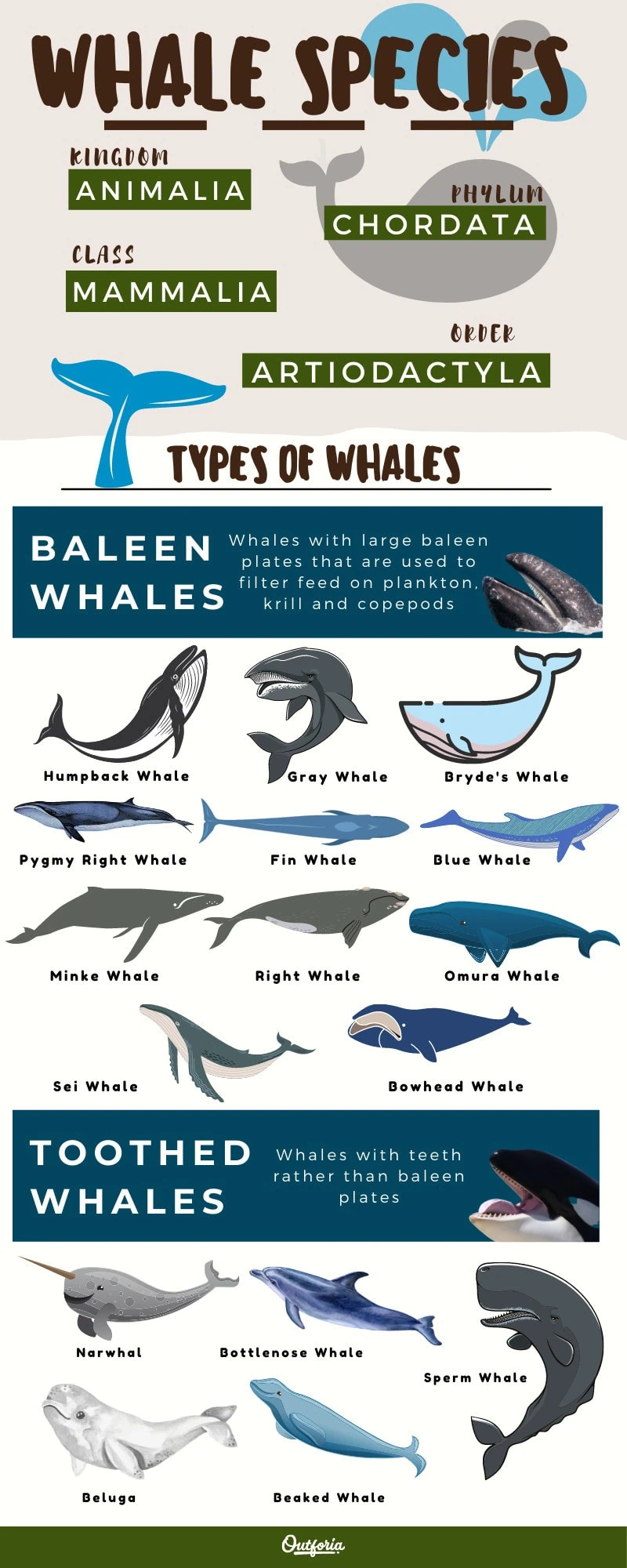
Whales are easily recognizable creatures found in oceans worldwide. However, due to the vast variety of whales that inhabit the Earth’s oceans, taxonomists have difficulties classifying them into specific groups.
Whales are classified as mammals and fall under the Animalia, Chordata, and Mammalia categories of the kingdom. They are also part of the Artiodactyla order, which includes all even-toed ungulates. You may question how whales can be considered ungulates since they don’t have hooves or feet.
This is where their evolutionary history comes into play. According to genetic research, whales evolved from even-toed ungulates, such as giraffes, antelopes, and goats, to become the impressive marine mammals we know today. So, in terms of genetics, whales are more similar to an alpaca than a shark. Who would have thought?
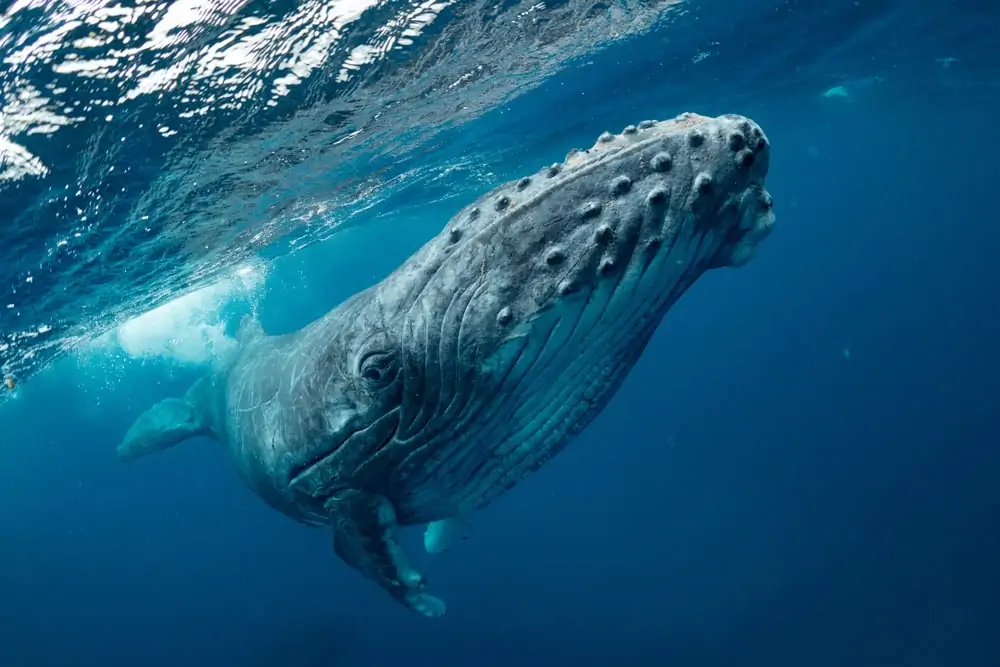
All whales are part of the Clade Cetancodonta, which includes Artiodactyla and is also shared with hippopotamuses. This suggests that hippos and whales share a common ancestor and are part of a single clade.
Whales are classified under the infraorder Cetacea, which comprises all cetaceans, including dolphins and porpoises, and are aquatic mammals that live in the ocean.
Within the infraorder Cetacea, there are two suborders or parvorders: Odontoceti (toothed whales) and Mysticeti (baleen whales). Baleen whales, such as the blue whale and humpbacks, belong to the Mysticeti suborder, which filters their food through baleen plates.
The word “whale” is commonly used to refer to all species of cetaceans, but this is incorrect as dolphins and porpoises, which are members of the Odontoceti suborder, are toothed whales and not baleen whales like their larger counterparts.

It’s important to understand that while all dolphins and porpoises are technically considered whales, not all whales are dolphins and porpoises. This can make things more complicated when it comes to classification.
Within the Odontoceti suborder, the creatures we call “whales” are mostly grouped into three families or superfamilies. The beluga and narwhal are part of the Monodontidae family, known as the “Arctic Whales.” The sperm whale, pygmy sperm whale, and dwarf sperm whale are part of another family of surviving whale species.
There are also many species in the beaked whale superfamily, which often resemble larger dolphins and have an exceptional ability to dive to great depths.
It’s worth noting that some creatures that may appear to be whales are actually classified as dolphins. For example, the orca or killer whale is a type of dolphin, albeit a large one. Similarly, the pilot whale, which is often referred to as a whale, is also classified as a type of dolphin. It’s a reminder that the world of whale taxonomy can be quite complex!
Types of Whales FAQs
To some of your most frequently inquired questions about various kinds of whales, here are our responses:
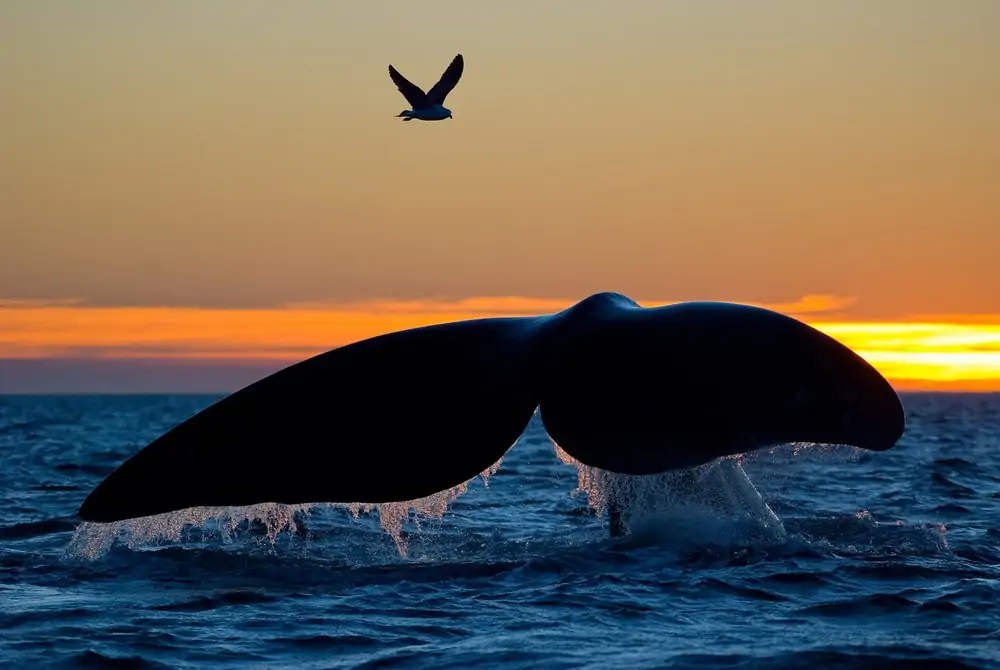
What are the two main types of whales?
Baleen whales and toothed whales are the two basic kinds of whales. Baleen whales, such as the humpback whale, have enormous baleen plates in their mouths that allow them to filter feed on krill and plankton. Teeth, on the other hand, are used for hunting fish and other bigger marine creatures by toothed whales such as the sperm whale.
How many types of whales are there?
In the oceans, there are around 40 different types of whales. Yet, since several creatures that are often referred to as whales might be better categorized as dolphins (a kind of whale), classification is tough.
Is a whale shark a whale or a shark?
A whale shark is a kind of shark, despite its odd name. Like all sharks, it is a fish, not a mammal like whales. Whale sharks, on the other hand, are filter-feeding whales that mostly consume krill, plankton, and other copepods. They are similar to baleen whales.
How old do whales live?
Most whale species have varied lifespans, ranging from 50 to 100 years. The bowhead whale, on the other hand, is thought to be the oldest living whale. The bowhead whale is thought to have a lifespan of more than 200 years, according to researchers.
Can a whale swallow a human?
Because their esophagus isn’t wide enough for a human body, most whales aren’t capable of fully swallowing a human. However, baleen whales have previously caught humans in their mouths and then spit them out. Being swallowed by a whale isn’t exactly the same as having a bad experience, but it’s not pleasant.
21 Different Types of Whales: List and Pictures
We couldn’t possibly list all of the different kinds of whales that swim through our planet’s oceans, so we’ll just mention a few. Yet, here are 21 of the world’s most amazing whale species!
1. Baleen Whales
Baleen whales filter feed on plankton, krill, and copepods using their baleen plates, which are a collection of whales. If you ever get the opportunity to see these whales in the wild, they are among the world’s greatest creatures and a genuine marvel to observe. Here is everything you need to know.
1.1 Bowhead Whale

The bowhead whale, scientifically known as Balaena mysticetus, is a medium-sized whale that has one of the longest lifespans among all animals on earth. These creatures inhabit only the Arctic and subarctic regions of the world. Despite the fact that humans have been hunting bowhead whales for centuries, they can survive for over 200 years if they are allowed to live out their natural lifespan.
In their natural habitat, bowhead whales possess unique physical characteristics that make them easily recognizable. They have the largest mouth of any animal, and while many other whale species have large lips, the bowhead’s tongue can grow up to 16 feet (5 m) long and weigh about 1 ton (900 kg).
Although the bowhead whale was almost driven to extinction during the height of the global whaling industry, a ban on bowhead hunting in the 1960s allowed the species to recover. As a result, the IUCN (International Union for Conservation of Nature) has classified the species as “of least concern” globally.
1.2 Southern Right Whale
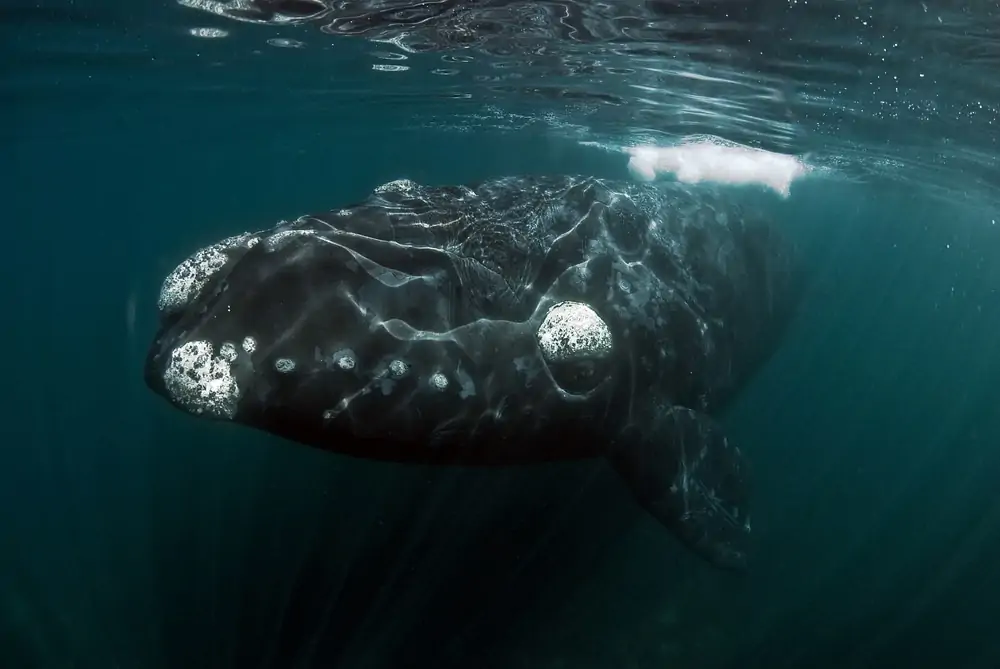
The southern right whale (Eubalaena australis) is one of the three species of right whales and is found only in the oceans between 20°S and 60°S. Although it resembles other right whales with its black body and large gray callosities on its head, it has its unique features that distinguish it from them.
Despite not being abundant, southern right whales are usually quite active near the water’s surface. They also have a natural curiosity towards boats and ships, and they tend to investigate when they encounter them.
During the nineteenth century, southern right whales were heavily hunted after the decline of the North Atlantic right whale population in the eighteenth century. However, by the mid-twentieth century, the killing of southern right whales had been prohibited in many areas, and the species is now protected. Despite this, the population has dwindled to the point where it is now considered an endangered species.
1.3 North Atlantic Right Whale

The North Atlantic right whale is a type of marine mammal known as Eubalaena glacialis that inhabits the northern Atlantic Ocean’s temperate and sub-Arctic waters. It is closely related to the southern right whale and is a slow-moving creature that can be found near the surface of the water, close to shore, and often entangled in fishing gear, posing a threat to its survival.
Commercial whaling in the 18th century brought the North Atlantic right whale close to extinction, and while it is currently protected in many areas, it is considered functionally extinct in the eastern North Atlantic. As a result, the International Union for Conservation of Nature (IUCN) has classified the North Atlantic right whale as critically endangered.
1.4 North Pacific Right Whale

The North Pacific right whale, scientifically known as Eubalaena japonica, is the third and final species of right whale. It is typically found in the coastal waters surrounding Alaska, western Russia, and Japan and only inhabits the northern Pacific.
Due to its limited population numbers and vast distribution range, the North Pacific right whale is seldom observed by boats, making it challenging for scientists to monitor and study the species.
Beginning in the 1830s, commercial whaling posed a severe threat to North Pacific right whales until the species was granted protection in the 1960s. Today, the species faces a variety of dangers, including oil spills, fishing gear entanglements, illegal whaling, and hybridization with bowhead whales. As a result, the International Union for Conservation of Nature (IUCN) has classified the species as “endangered.”
1.5 Pygmy Right Whale

The pygmy right whale (Caperea marginata) is a unique species that belongs to the family Neobalaenidae, despite its name similarity to other right whales. There were no confirmed sightings of this species until 2012, leading to the belief that it was extinct.
The Southern Ocean is where the pygmy right whale lives, and it was first scientifically described. There have been only about 25 confirmed sightings of this cetacean, making it one of the least researched marine mammals.
Despite being the smallest known baleen whale, measuring about 20 feet (6.1 m) long, the pygmy right whale is currently classified as a species of least concern by the IUCN. However, this is likely due to a lack of information rather than a true reflection of its conservation status.
1.5 Common Minke Whale

The common minke whale (Balaenoptera acutorostrata) is a small species of baleen whale that can be found in almost every ocean around the world. It is also referred to as the northern minke whale, while the dwarf subspecies is more commonly found in the Southern Ocean.
The common minke whale is one of the smallest species of baleen whales, and can be easily recognized by its small curved dorsal fin. Before diving, they perform a unique surfacing behavior of bringing their pointed rostrum to the surface and arching their back. They usually take several breaths before going on a deep dive.
After being heavily hunted during the commercial whaling era in the 18th and 20th centuries, the common minke whale is now protected in many areas. It has been designated as a species of least concern by the IUCN worldwide.
1.6 Southern Minke Whale
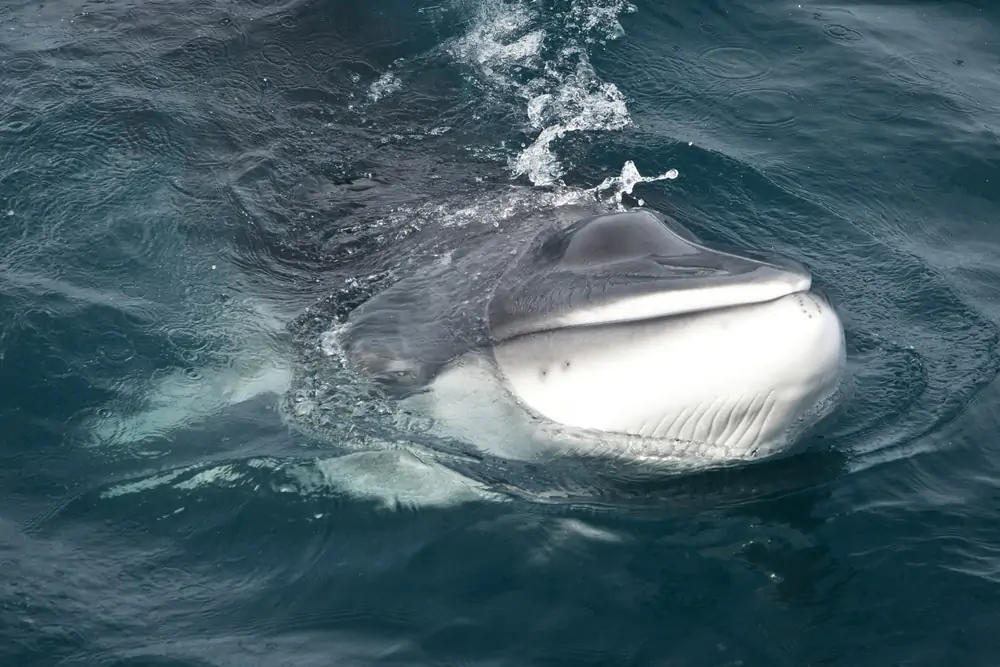
The Antarctic minke whale, also known as the southern minke (Balaenoptera bonaerensis), is a larger species compared to the common minke whale. It is exclusively found in the southern hemisphere and is more abundant in its range than the dwarf subspecies of common minke.
Unlike many other baleen whales, the southern minke was not heavily hunted by commercial whalers as it is less economically valuable due to its smaller size and low oil yield. However, the species is currently facing threats, such as overfishing of krill in its range and climate change, leading to its classification as “near threatened” by the IUCN.
1.7 Gray Whale

The gray whale (Eschrichtius robustus) is a massive marine mammal weighing up to 45 tons (40,820 kg), which is only found in small coastal regions worldwide. Although gray whales were previously distributed more widely, they were wiped out in Europe during the 6th century and in the eastern Atlantic during the 18th century.
One of the gray whale’s most notable characteristics is its lengthy seasonal migration route. Each population of gray whales migrates to distinct locations, with the eastern Pacific group traveling 5,000 miles (8,000 kilometers) from the Bering and Chukchi Seas to the Gulf of California every winter. This is considered to be the world’s longest annual migration by any species.
Despite the fact that orcas are known to prey on gray whales, human commercial whaling is likely the greatest threat to this species. Since it is no longer extensively hunted for commercial purposes, the IUCN has designated it as being of least concern.
1.8 Humpback Whale
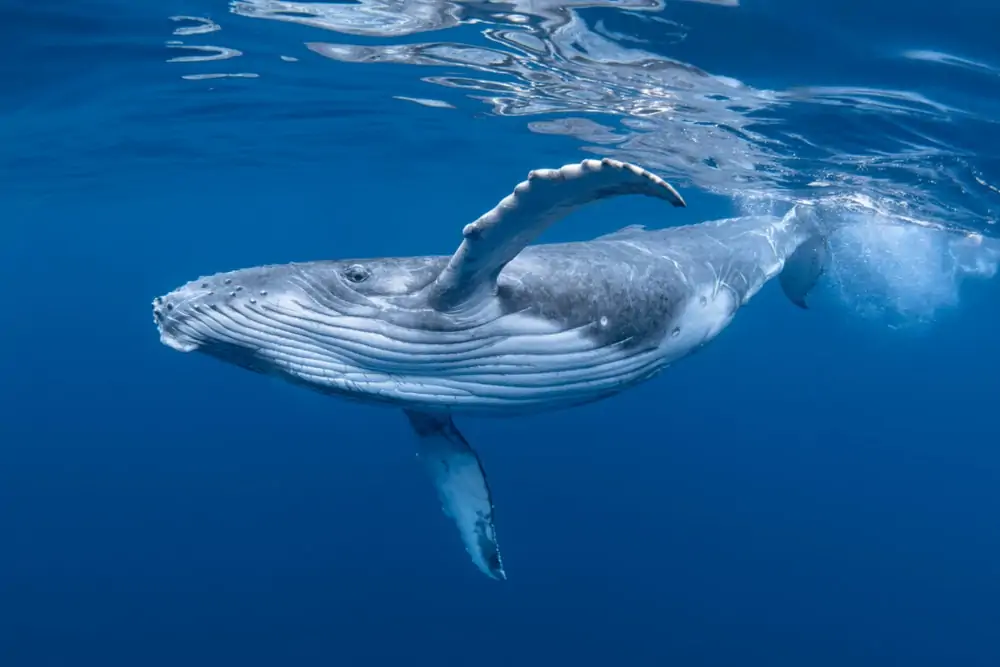
The humpback whale (Megaptera novaeangliae) is a large cetacean that can be found in almost all of the world’s oceans, making it one of the most widespread whale species. It is famous for its acrobatic breaching and impressive communication abilities. Male humpbacks create complex songs that can last up to 20 minutes, which are thought to be unique to different groups of humpbacks.
Humpbacks were heavily hunted by commercial whalers like other baleen whales until the 1960s, causing their populations to plummet. However, they have made a remarkable recovery and are now considered a species of “least concern” by the IUCN. They can be found in a range of habitats, from tropical waters to polar regions.
1.9 Blue Whale

The blue whale (Balaenoptera musculus) is an awe-inspiring cetacean, and it is also the largest known animal on the planet. It can grow up to 98 feet (29.9 meters) in length and weigh as much as 165 tons (150,000 kilograms).
Despite being the largest animal on earth, blue whales feed on tiny creatures such as krill. In a single day, a blue whale can consume up to 8,000 pounds (3,600 kg) of krill!
Blue whales are believed to inhabit almost all of the world’s oceans. Although they were once very abundant, they were almost wiped out during the 19th and 20th centuries. Today, the blue whale is listed as endangered by the IUCN, and it remains one of the least studied baleen whales.
1.10 Fin Whale

The fin whale, also known as the finback whale and scientifically named Balaenoptera physalus, is the second largest cetacean in the world after the blue whale. It can grow up to 90 feet (27 meters) long and weigh up to 80 tons (72,500 kg). These whales can be found in nearly every ocean around the globe, and are distinguished by their tall spout and large dorsal fin, though they can sometimes be mistaken for blue or sei whales from a distance.
During the commercial whaling era, fin whales were hunted extensively, particularly after the development of the explosive harpoon. Nearly 50% of the global population of fin whales were killed for their oil, blubber, and baleen. As a result, the species has been listed as endangered, despite showing signs of population growth in recent years.
1.11 Omura’s Whale
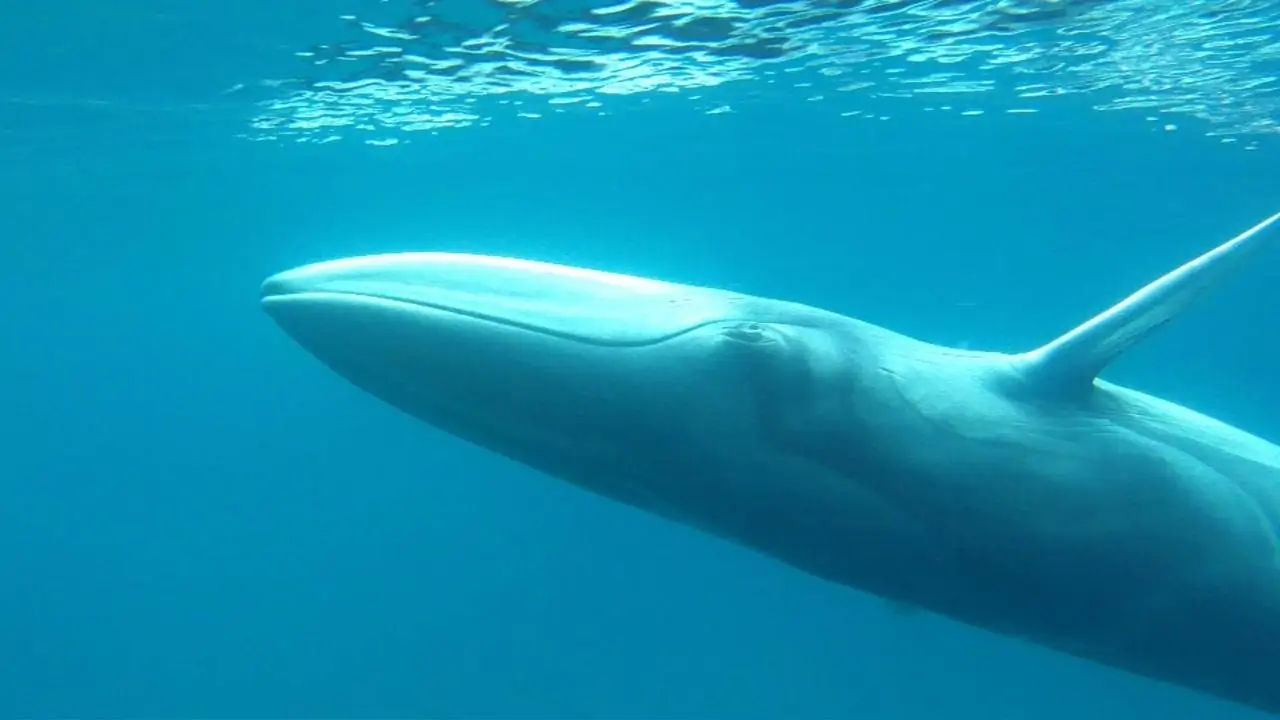
The Omura’s whale (Balaenoptera omurai), which is also known as the pygmy form of the Bryde’s whale, is a large baleen whale that has received little scientific attention. In the Indo-Pacific Ocean, there is believed to be one population of these whales, with a possibility of a second population in the Atlantic. Although there have been some confirmed sightings of Omura’s whales in the past, their true range is not well understood.
While the Omura’s whale may have been hunted for food in Oceania over the last few thousand years, it was never a significant target of commercial whaling. However, due to limited data on their population dynamics, the IUCN currently lists the species as “data deficient.”
1.12 Eden’s Whale

The Bryde’s whale complex includes the disputed baleen whale species Eden’s whales (Balaenoptera edeni). Although physical similarities connect the three species in the Bryde’s whale complex (Rice’s, Eden’s, and Bryde’s whales), further investigation is needed to determine their relationship.
Eden’s whales are believed to be primarily located in the western Pacific, with the Bay of Bengal, the Gulf of Martaban, and the East China Sea being their preferred habitats. The Eden’s whale, also known as the Sittang whale, is believed to be the smallest of the species.
The IUCN has classified Eden’s whale as a species of low concern, but little is known about its worldwide population. Collisions with ships, pollution, and the depletion of its food source due to commercial krill fishing are among the major risks to the species.
1.13 Rice’s Whale
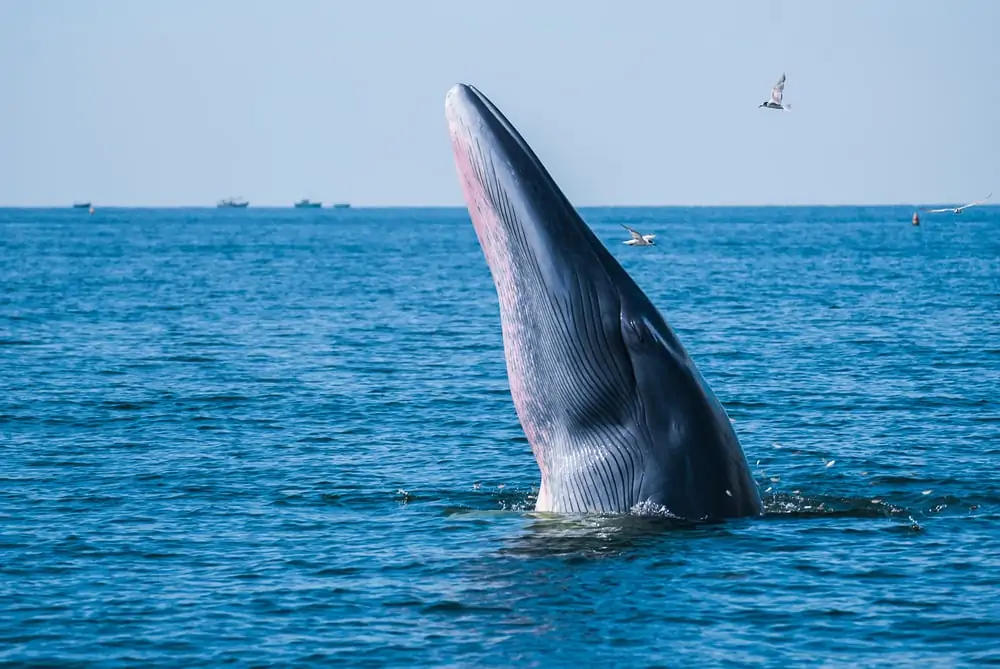
The Rice’s whale (Balaenoptera ricei), previously considered a distinct species from Bryde’s whale based on genetic analysis, is one of the most well-studied members of the Bryde’s whale complex. Recent genetic research has shown that it is a subpopulation of Bryde’s whale.
Unlike most Bryde’s whales, the Rice’s whale spends most of its time in the Gulf of Mexico, specifically along the northern Gulf coast’s continental slope in Florida. Despite being designated as a separate species in 2021, the IUCN has not yet classified the Rice’s whale. However, it is considered an endangered species under the US Endangered Species Act and is protected in its range. The primary threats to the species include vessel collisions, pollution, and acoustic disturbances from shipping and oil exploration.
1.14 Sei Whale

The sei whale (Balaenoptera borealis) is the third-largest cetacean on Earth and is usually found in offshore areas with deep water. It prefers temperate and subtropical regions and avoids both polar and tropical waters, but can potentially live anywhere in the world. Sei whales are among the fastest cetaceans, capable of reaching speeds of over 31 mph (50 km/h) for short distances. With an average weight of up to 50 tons (45,400 kg), the sei whale is a truly massive marine mammal.
During the commercial whaling era, sei whales were a popular target due to their large size. As a result, the population is estimated to have declined by one-third during the 20th century. However, with the current increasing population, the species is now classified as endangered.
1.15 Common Bryde’s Whale

The common Bryde’s whale (Balaenoptera brydei) is the largest cetacean within the Bryde’s whale species complex. Its taxonomic status, whether as a separate species or a closely related subspecies of the Eden’s whale, is a matter of debate among scientists.
These whales are found in the warmer temperate and tropical seas of the Indian, Pacific, and Atlantic Oceans, and they prefer to live in the open ocean.
The population trends of the common Bryde’s whale are not well understood, partly because of taxonomic uncertainty. The species is known to be vulnerable to disturbances, with vessel collisions being a major threat to them, especially in the open ocean.
2. Toothed Whales

Toothed whales are a type of cetacean that have teeth instead of baleen plates, and they belong to the cetacean suborder Odontoceti, which also includes porpoises and dolphins.
There are over 70 species in the Odontoceti suborder, with the majority being various types of dolphins and porpoises. Interestingly, orcas are actually classified as dolphins rather than whales in this suborder.
In this discussion, we will focus on six toothed whale species that are commonly recognized as true whales by taxonomists. Here are some of the most fascinating toothed whales that inhabit our oceans.
2.1 Sperm Whale
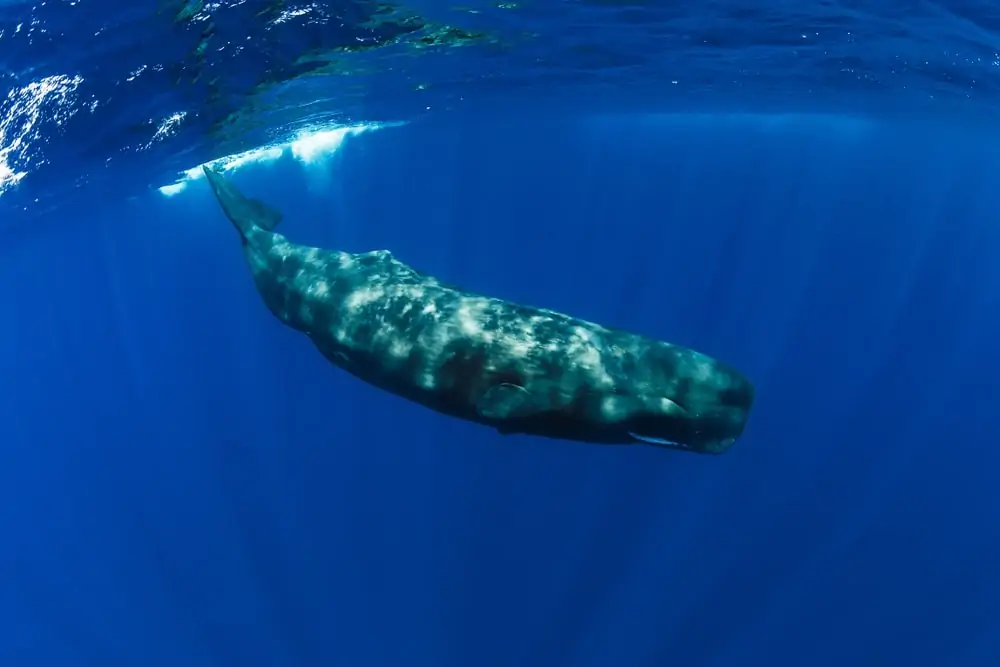
The sperm whale, also known as Physeter macrocephalus, is the largest toothed whale in the world and the only living species of its genus. Sperm whales gained popularity in mainstream culture due to Herman Melville’s book Moby-Dick, where a large white sperm whale named Moby Dick bit off Captain Ahab’s leg. The term “sperm whale” is a short form of “spermaceti whale,” named after the semi-liquid, waxy material found in the whale’s melon or forehead. This substance is believed to help sperm whales produce clicking sounds for communication and echolocation. In the past, commercial whalers targeted the spermaceti for use in producing candles and other products, and the ivory-like teeth of the sperm whale were also highly valued. However, due to hunting, the sperm whale now has a small population and is classified as vulnerable.
2.2 Narwhal
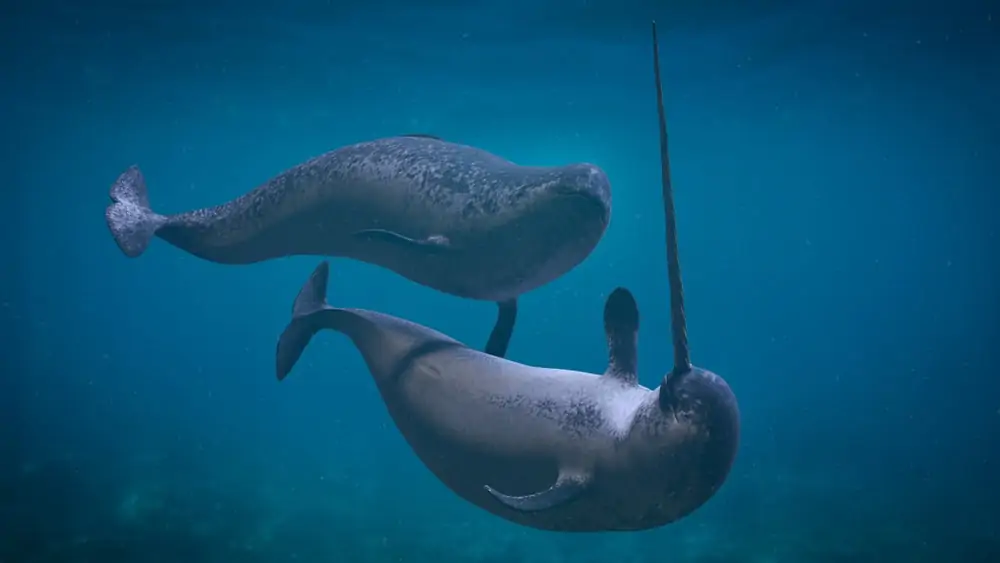
The narwhal, also called the “unicorn of the sea,” is a distinct-looking cetacean recognized for its long tusk-like protrusion, which can grow up to 10 feet long in males and occasionally in females. The tusk is, in fact, a canine tooth that grows in a helical spiral throughout the narwhal’s life, extending from the left side of the whale’s upper jaw.
Recent research shows that billions of nerve receptors in the tusk provide sensory information about the narwhal’s environment. Narwhals are found exclusively in Arctic waters, where they have been hunted by Indigenous peoples such as the Inuit for cultural and subsistence purposes for thousands of years. Despite the dangers posed by climate change and changing sea ice conditions, the IUCN lists the species as “least concern.”
2.3 Southern Bottlenose Whale

The southern bottlenose whale (Hyperoodon planifrons) is a cetacean found in the Southern Ocean surrounding Antarctica. This species is not well-understood, and little is known about its behavior and population size. The southern bottlenose whale is a type of beaked whale and is assumed to be predominantly white and gray in color. It can dive for up to 40 minutes, allowing it to reach deep ocean waters. While the IUCN currently lists the species as of “least concern,” little is known about the threats it faces. Further research is necessary to better understand this enigmatic species.
2.4 Beluga

The beluga whale (Delphinapterus leucas) is a unique and easily recognizable cetacean due to its all-white body and large, melon-shaped head. It is sometimes referred to as the “sea canary” due to its high-pitched vocalizations, which it uses for echolocation and communication in dark waters. The beluga’s melon is also important for its communication abilities, as it can function as an acoustic lens to project its calls over longer distances.
Despite being currently classified as a species of low concern by the IUCN, the beluga whale faces a number of threats. Climate change poses a risk to the species’ Arctic habitat, while human activities such as ocean pollution and noise pollution can also be harmful to belugas.
2.5 Baird’s Beaked Whale
The Baird’s beaked whale (Berardius bairdii) is a beaked whale species that prefers deep water ecosystems in the northern Pacific Ocean. There is some debate as to whether Baird’s beaked whales and Arnoux’s beaked whales are the same species due to their similar features. If they are the same species, Baird’s whale’s range would encompass much of the Southern Ocean.
Baird’s beaked whales are well-known for their huge size and timidity. They have deeper colorations compared to other beaked whales, but further research is required to understand the species’ genuine range of appearances. The species is protected in the United States, but the IUCN has classified it as a “species of least concern.”
2.6 Cuvier’s Beaked Whale

Cuvier’s beaked whale, also known as Ziphius cavirostris, is believed to be the most widely distributed beaked whale in the world, except for the colder polar waters. This species can be found in almost every ocean on the planet.
These whales have a small beak, and their bodies are shaped like a cigar. Male Cuvier’s beaked whales sometimes have two small tusks in the corners of their lower jaw, although their purpose remains unknown.
Cuvier’s beaked whales are exceptional divers and can spend hours underwater, similar to other beaked whale species. In fact, one individual was identified using a tag that recorded a depth of over 9,800 feet (2,900 meters), making it one of the deepest dives ever recorded by any animal. Despite being widely distributed, the species’ population status is unknown, and more research is needed to understand the threats it faces.
